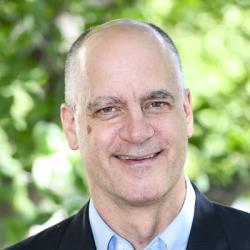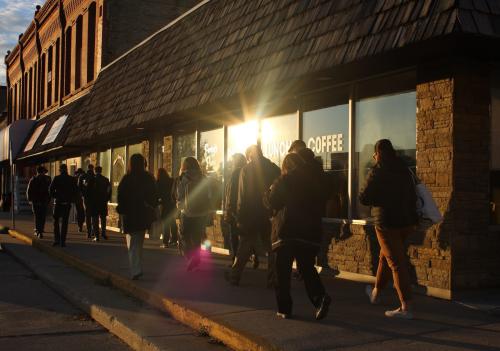Rural areas across America face a range of barriers to attracting adequate investment for community and economic development. Even before the pandemic, rural communities were still grappling with the effects of the 2008 Great Recession, as employment and working-age labor force participation rates remained below 2007 levels. In 2022, as the nation’s local economies recovered from the COVID-19 pandemic, the share of U.S. GDP from rural areas fell to its lowest point ever, continuing a steady decline that began in 2001.
It is in this context that the Economic Recovery Corps (ERC)—launched in 2022 through a cooperative agreement between the Department of Commerce’s Economic Development Administration (EDA) and the International Economic Development Council (IEDC)—presents a promising new model. Part of a larger movement of place-based policy to help revitalize left-behind communities, the ERC program is unusual in its focus on providing human—rather than financial—capital to communities, by embedding experienced economic development professionals in places where local capacity to plan and pursue investment is often limited.
The IEDC, along with six national partners,1 is implementing the multi-year effort and placed 65 fellows at local host organizations in February 2024 for a 30-month term. For many rural places—often described as “development deserts”— the ERC represents a rare opportunity to directly and quickly address a key issue: their limited administrative capacity and access to expertise on economic development, especially expertise steeped in their place’s distinctive history, assets, and potential.
Early signals suggest the program is attracting high-caliber talent and delivering meaningful gains at a relatively low cost. The ERC’s emphasis on bringing experienced professionals for long-term, immersive engagements goes beyond the service orientation of fellowship programs such as AmeriCorps or Peace Corps, or the short-term technical assistance of most federal capacity-building programs.
The program is not exclusively focused on rural communities. Yet given its focus on attracting development specialists and strengthening operating capacity, the program seems tailor-made for addressing many of the key capacity challenges that rural places face. With fellows having passed the first full year of their tenures, this analysis examines the degree to which rural areas are participating in the program and provides early insights into its impact in those regions.
How the Economic Recovery Corps program works
The ERC program is structured around a two-part competition: one to select host organizations, and another to recruit and place fellows. Host organizations were chosen based on demonstrated need, readiness to support a fellow, and alignment with the EDA’s investment priorities. These hosts—ranging from local governments to regional nonprofits—submitted work plans outlining their goals, existing capacity, and the role a fellow could play in advancing locally driven development efforts.
From a pool of more than 1,400 applicants, 65 fellows were selected and matched with hosts based on their professional backgrounds and alignment with host needs. Most fellows are experienced professionals, typically mid-career, bringing between 6 and 15+ years of experience in supporting entrepreneurship and/or advancing community, small business, and workforce development.
Fellows did not arrive with pre-set mandates, but are instead assigned to work alongside host staff to shape and execute strategic economic development initiatives. These priorities might include strengthening small business ecosystems, advancing regional workforce plans, expanding housing development, or helping communities navigate and access public funding.
The ERC is designed not only to deliver local impact, but also to generate field-wide insights. Fellows and hosts participate in peer learning cohorts, receive regular coaching, and contribute to a growing body of shared tools and practices.2 This is a more sustained and intensive support structure than similarly motivated federal programs have had in the past.3
To assess how rural communities are participating in the program, we conducted a qualitative review of ERC awardees and grouped them into three categories: rural-centered (based in or primarily serving rural areas), partially rural (serving mixed geographies), and non-rural (serving exclusively urban or suburban communities). Selected host organizations led by or dedicated to Indigenous communities received a distinct Indigenous-focused designation.
The rural demand for economic development expertise
The ERC received 509 applications from potential host organizations, making it one of EDA’s most popular programs ever. Almost 80% of the applicants claimed to serve at least some rural places4 within the territory they cover; 45% of those applicants served exclusively rural areas. The applicants represented a diverse range of entities, such as local governments, nonprofit organizations, economic development districts, and both public and private sector regional development groups. The program emphasized being flexible to such a broad range of applicants and project objectives, since the civic infrastructure in low-capacity places can vary so widely.
This demand for ERC fellows from rural-serving entities reflects the constraints on capacity in rural places. Rural governments often lack economic development specialists, grant writers, and access to other expertise to put together and manage new projects and economic ventures. When rural localities get access to such expertise, it is often based on relatively short-term, project-centered philanthropic grants or similar support from state governments. Among the rural-serving applicant organizations to the ERC, more than 82% reported that the communities they represent have historically struggled to access federal, state, and philanthropic support for local or regional development efforts.
The pool of applicants highlights the success of the coalition’s outreach in partnership with EDA to communities pursuing economic revitalization. Of the 509 ERC applicant organizations, 85% are located in regions that include Opportunity Zones, and 49% are in areas that qualify for New Market Tax Credit (NMTC) incentives.5 In addition to matching EDA’s investment priorities—critical infrastructure, workforce development, innovation and entrepreneurship, economic resiliency, and manufacturing—selection was based on a variety of other factors, such as a leadership team or advisory board committed to collaboration and a solid understanding of regional assets and challenges that could impact the success of a fellow’s efforts.
A majority of EDA’s Economic Recovery fellows are serving rural areas
The ERC partner coalition selected 65 organizations to act as host sites. Of the 65 awardees, 40 are rural-centered, 11 are partially rural in their program objective’s scope, and 14 have no rural focus. Of those 40 rural-centered awardees, 8 have a focus on improving economic conditions in Indigenous communities.6
Overall, the selected hosts are located across 44 states and territories and represent a cross-section of rural, urban, and tribal communities. Thirty-four hosts, or just over half of all awardees, come from either the southeast or midwestern U.S.
Among the 40 rural-centered ERC hosts, 18 identified economic development as their top priority, 11 prioritized improving quality of life, seven focused on workforce development, and three listed e-connectivity or broadband as their primary objective.7
Early successes
While it’s difficult to assess the progress of the ERC in the middle of the program, one measure of success is the additional investment secured by fellows.
By February 11, 2025—about a year into the ERC fellows’ tenure—the host organizations had accessed an estimated $135.6 million in total investment from 27 different funding sources.8 The work of the fellows contributed to about two-thirds of this new investment by identifying new opportunities for the host organization, or by strengthening successful applications through strategic planning expertise or development of new concepts and designs.
These results point to a substantial return on the initial $30 million investment in the program. Having said that, it is important to note that this $135.6 million in funding has been concentrated among just 20 of the 65 fellows’ projects; the benefits to date have not been equally distributed across all host sites. Given the complexity and amount of time involved in developing successful projects, future analysis could helpfully investigate when, where, and how fellows’ contributions were critical to accessing investment amid local constraints.
When categorized by project, the types of funding sources are as follows: private (48% of projects), federal (32% of projects), and state (20% of projects). Over $93 million is going to rural-centered hosts.9 Tribal groups attracted almost all of the remaining investment at $40.9 million.
In terms of the total amounts invested, the majority has come from public sector sources—both federal and state—amounting to $127.1 million, or 93.7% of the overall funding. Sources for public funding vary, including the Department of Commerce, U.S. Department of Agriculture Rural Development (USDA-RD), and EDA programs such as the Recompete Pilot Program. The remaining $8.5 million comes from private sources such as regional development groups, local nonprofits, and financial institutions. Of this, over $3.2 million in private funds went to rural-centered hosts.
Key conclusions
The ERC represents a significant experiment in embedded capacity—one that attracted the attention of many rural areas, given their limited capacity. Those limits often hinder their ability to develop projects or prepare proposals for attracting investment, manage complicated projects, and build or maintain crucial infrastructure over the long term. The ERC stands to offer important lessons on what works to strengthen the capabilities of rural regions that struggle to attract investment.
The ERC, for a relatively low cost, has managed to attract high-quality talent to “development deserts.” Embedding fellows directly in underserved rural areas—working side by side with local governments, leadership, and residents—positions them to produce research and projects tailored to the community’s specific needs. Early indications are that this boost in capacity could result in considerable gains in investment.
Given the complexity of launching and sustaining economic development projects, the full impact of the ERC will not be clear until the fellows’ terms are complete—and even beyond. Yet in just one year, ERC fellows appear to have helped attract new investment from 37 different sources for 27 different projects.10
To fully measure the ERC’s impact would mean having the IEDC and its partners track sustained outcomes in participating communities, preferably with expertise provided by a third-party evaluator. Ideally, EDA’s support would provide for a rigorous evaluation so that policymakers can benefit from lessons generated by the program and pursue appropriate follow-up action. Such evaluation could involve, for example, comparing economic indicators across similar communities that did not receive ERC support or conducting follow-up interviews with local officials to assess whether gains in workforce development, entrepreneurship, tourism, or small business support have been sustained. Understanding whether and how this embedded model delivers durable capacity improvements will be critical to understanding the extent of its long-term return on investment.
That return on investment could be substantial as fellows continue to develop projects and opportunities throughout the rest of their terms, yet there are also key questions as to the amount of time necessary to achieve success with these new ventures. It will be important to ensure the fellows remain for the entire duration of their planned engagements, given the plans they are putting in place. Evaluation of the program should also seek to provide insights into the amount of time necessary to move the needle in selected communities.
The ERC offers a compelling case for how modest federal investments in capacity can yield outsized impacts in rural regions facing persistent capacity constraints. By connecting local organizations with experienced practitioners, the program strengthens operational capabilities, enables longer-term economic strategies, and lays the groundwork for sustainable development. As policymakers weigh budget priorities, this analysis suggests that they would do well to maintain, invest in, and learn from the ERC and other programs that are being successful in building and sustaining local capacity, given the potential for relatively small federal investments to leverage significant returns.
-
Footnotes
- These organizations include the Center on Rural Innovation (CORI), the International City/County Management Association (ICMA), the National Association of Counties Research Foundation (NACo RF), the National Association of Development Organizations Research Foundation (NADO RF), the National League of Cities Institute (NLCI), and RAIN Catalysts.
- Much of the data used in this analysis—including application materials, fellow backgrounds, and funding figures—was provided by IEDC.
- One example is the U.S. Department of Housing and Urban Development’s Community Builder Fellows program, launched late in the Clinton administration. Its goals were broadly similar to those of the ERC—emphasizing greater access to public investment, especially for disadvantaged communities and underserved partners—but HUD’s fellows worked for the agency, not local governments or nonprofits. Peer learning was largely informal, and the fellows received limited, front-end orientation and training from HUD. See Ernst & Young’s early assessment report, commissioned by HUD in 1999.
- Host organizations identified whether their project would serve rural, suburban, urban, or mixed populations in their application materials.
- Only 10.3% of U.S. census tracts are designated as Opportunity Zones, and 40.3% qualify for NMTC support.
- The IEDC highlights eight Indigenous-focused groups differently, identifying Mountain BizWorks instead of our selection, The United Keetoowah Band of Cherokee Indians.
- One rural-centered awardee, Wallowa Resources, did not list its project priorities in any order.
- Authors’ analysis based on data supplied by IEDC.
- This does not include dual urban-rural focused groups, which secured $750,000 in investments.
- The number of ERC-related investments may have increased since the IEDC provided funding data to us.
The Brookings Institution is committed to quality, independence, and impact.
We are supported by a diverse array of funders. In line with our values and policies, each Brookings publication represents the sole views of its author(s).





Commentary
EDA’s Economic Recovery Corps is bringing much-needed capacity to rural places seeking to attract investment
August 6, 2025